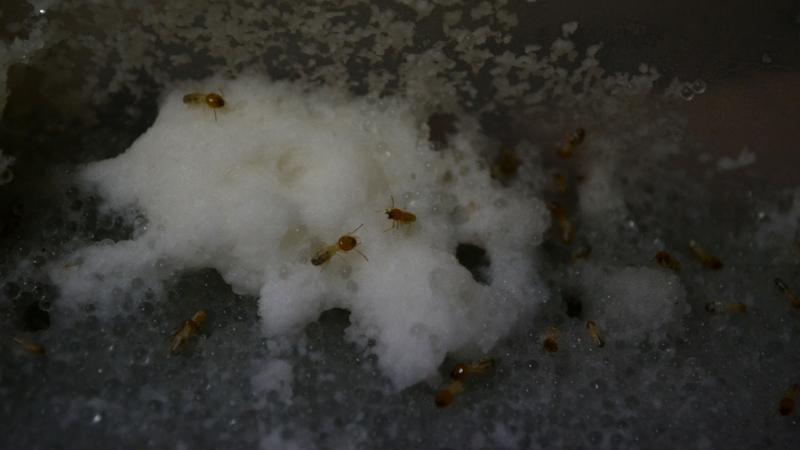
Termites are often thought of as pests that wreak havoc on our furnitures, doors, windows and anything made of wood. But, some termites deserve far more appreciation that they actually get! Wonder why? Because they were the first ‘farmers’ on the planet, growing their own food. Their farms do not look like ours, but consist of a variety of fungi grown in their nests to feed on. In turn, the termites help the fungi thrive, thus establishing a mutualistic relationship.
However, there are a few species of fungi that make their way into the farm as weeds, who do not help the termites in any way. So how do the termites get rid of them? Unlike us, termites do it without pesticides, by just sniffing out the weed fungi, says a new study by researchers at the Indian Institute of Science (IISc), Bengaluru, and École Nationale Supérieure de Chimie de Montpellier, Montpellier, France. In their study published in Journal of Chemical Ecology, the researchers have discovered that fungus-farming termites are able to discriminate against the weedy fungi and selectively bury them because they smell different than the crops.
In their study, published in Journal of Chemical Ecology, the researchers introduced worker termites of the species Odontotermes obesus inside cell culture dishes containing two types of fungi -- Termitomyces, the crop fungus that is grown by the termites, and Pseudoxylaria, a weedy fungus. These fungi were kept equidistant from the center of the dish. The researchers observed that the termites plowed the agar medium in which the fungi were kept, to form small aggregates called ‘boluses’. “Making boluses is a constitutive activity in termite workers wherein they form boluses and attempt to deposit them whenever they are offered material that they can handle, such as soil or agar”, explained Prof. Renee Borges from IISc.
The researchers then observed that the termites dumped a greater number of boluses on Pseudoxylaria than Termitomyces. A similar behaviour of the worker termites was observed when the agar medium in the culture dish was replaced with garden soil, indicating similar burial responses in natural ecosystems.
The real test began when the researchers decided to block physical access to both the fungi in a completely dark environment, to simulate the interiors of a termite nest. Now, this was more of a challenge of smell since the termites could not see the fungi. To their excitement, the researchers found that the fungal farmers were still able to distinguish the weed fungus from the crop, on the basis of their scents alone! They continued to bury the weedy fungi with a significantly greater mass of boluses when compared to the crop fungi.
So, do these fungi smell different? A comparison of the scent profiles of Pseudoxylaria and Termitomyces revealed that sesquiterpene compounds such as aristolene and viridiflorol, which are found in many living systems, exclusively constituted the smell of the weed.
In another experiment, the researchers used Pseudoxylaria and a blank plug (either a non-crop, non-weed fungus, or nothing at all), and the termites again preferred to deposit more boluses on the weedy Pseudoxylaria, indicating that similar burial behavior persists even in the absence of the crop fungi. However, when a blank plug and Termitomyces were used, the researchers observed no significant difference between the amounts of deposition of boluses close to these two fungi.
It is a bit of mystery why the termite workers deposit boluses on the crop fungus at all, given the mutualistic relationship between them. But, the relatively lower amounts of bolus deposition on Termitomyces were suggestive of the release of non-specific fungicides in the form of feces and saliva during the process of burial.
“If the termites are unable to differentiate between crop and weedy fungi, then they risk poisoning their own crops,” Dr. Borges told Research Matters. But, “several evolutionary scenarios are possible”, she added. For example, the weedy fungus may evolve a scent similar to a crop fungus, thus escaping detection. Another interesting possibility could be that the divergence of the scent of the crop fungi from the weedy fungi helps termites to evolve the application of fungicides that are specific to the weedy fungi. “These scenarios can be viewed as arms races between termites, crop fungi and weedy fungi, with each player in the game evolving its own strategy to survive”, she remarked.
The study also sheds some light on how insect workers might recognize and selectively mount chemical defenses against farm parasites. There is definitely lots to learn for us from the earliest farmers, starting from the art of controlling weeds.
“Indiscriminate application of pesticides is a universal problem in any farm, especially due to the evolution of resistance and also the cost of such large-scale application. These factors will impact on crop output in any farm”, said Dr. Borges, drawing similarities between our farms and the termite farms. Maybe, there is a lesson or two we can learn from these termites and go smell out the weeds!






